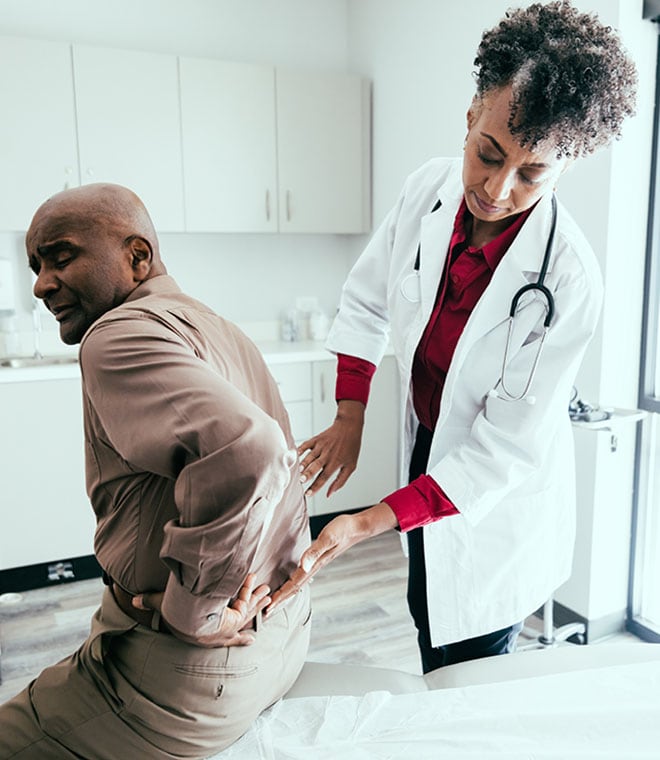Health
Back muscle strains: Symptoms and treatment
Clinically reviewed by Nancy Kupka, PhD, RN May 10, 2022 • 7 min.
It's estimated that 80% of American adults have or will experience pain in their upper back or lower back at some point. Until you join the club, it's difficult to comprehend the take-your-breath-away, sharp pain that accompanies a sudden onset of back strain.
Most cases of back pain are related to a muscle strain rather than a more serious condition, like arthritis, infection, fracture or cancer. And while there's no cure for back strain, the best we can do is to know the signs of a strain, practice smart core muscle hygiene, and take the right steps during treatment to get limber and healthy again.
Back strain prevention
While a lot of people may have a friend who's first to remind others to "lift with the legs, not the back," that sage advice can't prevent 80% of us from ending up hurt. Instead, it's more important to think about the movements, behaviors and conditions that could make you predisposed to back strain.
The National Institute of Neurological Disorders and Stroke outlined a few factors that could cause or complicate back pain. They include:
Jobs requiring heavy lifting, pushing with twisting motions or inactive desk jobs—especially those with poor posture or inadequate back support
Weight gain or obesity
Bone diseases, such as arthritis or osteoporosis
Kidney stones or related kidney infections
It makes sense. If we're asking our back muscles to take on more work, these conditions can lead to back strain.
While back pain can be sudden, the development of symptoms that make you predisposed to back pain doesn't have to be. Some conditions can take months, even years, before you are aware of them. Still, you can make some lifestyle changes that make back pain less likely, without the need of a physical therapist or a trainer, with purposeful, committed actions in small doses throughout the day. Habits can be healthy, after all. Habits linked to a common activity in your life may help you stick to them.
Here are some tips for improving your posture and core strength:
Remember it. Check your posture when stopped at a red light or first sitting in your office chair for the day. Adjust your shoulders and shoulder blades. Sit up. Breathe in deeply. Maintain the shape.
Lift it. Engage your core and give your back a workout for a few minutes nightly while watching television or relaxing. Grab a foam roller or a demi roller (a foam roller sliced in half) and place it in the middle of your back, let your body stretch and breathe. Gradually, work on balancing on the roller/demi roller while you lift your arms or legs, eventually working toward gradual, slow situps. Be careful not to roll too close to your neck.
Work it. Strengthen muscles using exercise bands, hand-held weights or exercises that take advantage of your body weight, such as pushups, pullups, planks, squats or lunges. Even five minutes a night can make a huge impact over a few weeks.
Walk it. You can walk your back strain away by taking your dog for a walk around the neighborhood or meeting regularly each week with a friend to walk. The more you walk, even at a casual pace, the better the opportunity for your body to adjust itself. Movement is good for your body. You don't have to be sweating to be doing something healthy.
Network it. If you feel like making the process of strengthening your core a little more formal while enjoying support of friends or class members, try joining a local Pilates or yoga class. Sign up for a charity walk. Walk on the treadmill at the gym. Focus on moving. Your body will respond.
Back strain treatment
If you're already experiencing back strain, there's no reason to feel like it's too late. Talk to your healthcare provider and develop a plan to reduce the pain and regain your strength and mobility.
Be prepared to answer questions about how your back strain occurred—whether it happened in an accident or had a sudden onset—and about your general routine. Your healthcare provider might ask where the pain is, whether it's persistent or intermittent, or where it rates on a scale of 0 to 10.
Your healthcare provider or a physical therapist might recommend specific exercises and movements that can help loosen the tight muscles and begin to restore strength. Often, the prescription will be movement, whether it's supervised in a physical therapy session or in your neighborhood with your four-legged best friend.
Depending on the injury and your healthcare provider's assessment, you also might be asked to try the following:
Ice or heat packs/patches
OTC pain medications, such as ibuprofen, aspirin or acetaminophen
Prescription medications, such as muscle relaxers or pain relievers
Topical remedies, such lidocaine patches, gels, creams or sprays to apply to your back that may provide relief
We all may know someone who's experienced back pain and may find it difficult to know when the pain we're experiencing is serious or not. If the pain is new or changing, with feelings of tingling sensations or numbness, you cannot walk more than a few steps, you feel a lump or have an area with an unusual shape, or your pain interferes with your sleep, it's important to call your healthcare provider.
Through an exam or diagnostic testing, your healthcare provider can determine whether you're experiencing muscle strain, a medical condition affecting your spine or are feeling nerve pain, such as sciatica. To help diagnose the source of the pain or severity of the injury, your healthcare provider may order an X-ray or CT scan to best understand your condition.
Clinically reviewed and updated May 2022.
Sources:
- https://www.ninds.nih.gov/low-back-pain-fact-sheet?search-term=Disorders%20Patient%20Caregiver%20Education%20Fact%20Sheets%20Low%20Back%20Pain%20Fact%20Sheet%20Accessed
- https://www.aans.org/Patients/Neurosurgical-Conditions-and-Treatments/Low-Back-Pain
- https://health.gov/paguidelines/second-edition/pdf/Physical_Activity_Guidelines_2nd_edition.pdf
- https://my.clevelandclinic.org/health/diseases/10265-back-strains-and-sprains



